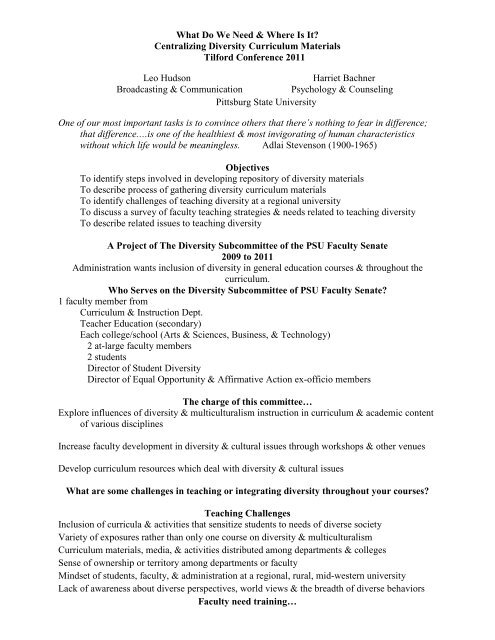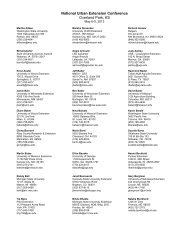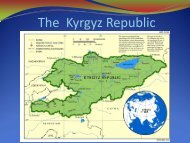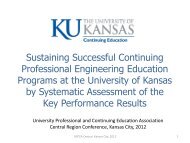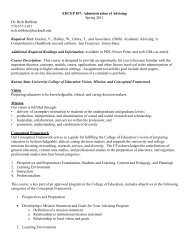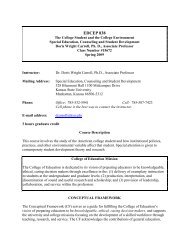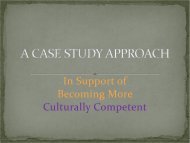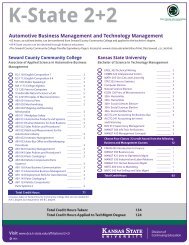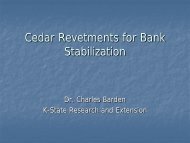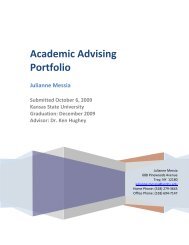Centralizing Diversity Curriculum Materials Tilford Conference 2011 ...
Centralizing Diversity Curriculum Materials Tilford Conference 2011 ...
Centralizing Diversity Curriculum Materials Tilford Conference 2011 ...
Create successful ePaper yourself
Turn your PDF publications into a flip-book with our unique Google optimized e-Paper software.
What Do We Need & Where Is It?<strong>Centralizing</strong> <strong>Diversity</strong> <strong>Curriculum</strong> <strong>Materials</strong><strong>Tilford</strong> <strong>Conference</strong> <strong>2011</strong>Leo HudsonHarriet BachnerBroadcasting & CommunicationPsychology & CounselingPittsburg State UniversityOne of our most important tasks is to convince others that there’s nothing to fear in difference;that difference….is one of the healthiest & most invigorating of human characteristicswithout which life would be meaningless. Adlai Stevenson (1900-1965)ObjectivesTo identify steps involved in developing repository of diversity materialsTo describe process of gathering diversity curriculum materialsTo identify challenges of teaching diversity at a regional universityTo discuss a survey of faculty teaching strategies & needs related to teaching diversityTo describe related issues to teaching diversityA Project of The <strong>Diversity</strong> Subcommittee of the PSU Faculty Senate2009 to <strong>2011</strong>Administration wants inclusion of diversity in general education courses & throughout thecurriculum.Who Serves on the <strong>Diversity</strong> Subcommittee of PSU Faculty Senate?1 faculty member from<strong>Curriculum</strong> & Instruction Dept.Teacher Education (secondary)Each college/school (Arts & Sciences, Business, & Technology)2 at-large faculty members2 studentsDirector of Student <strong>Diversity</strong>Director of Equal Opportunity & Affirmative Action ex-officio membersThe charge of this committee…Explore influences of diversity & multiculturalism instruction in curriculum & academic contentof various disciplinesIncrease faculty development in diversity & cultural issues through workshops & other venuesDevelop curriculum resources which deal with diversity & cultural issuesWhat are some challenges in teaching or integrating diversity throughout your courses?Teaching ChallengesInclusion of curricula & activities that sensitize students to needs of diverse societyVariety of exposures rather than only one course on diversity & multiculturalism<strong>Curriculum</strong> materials, media, & activities distributed among departments & collegesSense of ownership or territory among departments or facultyMindset of students, faculty, & administration at a regional, rural, mid-western universityLack of awareness about diverse perspectives, world views & the breadth of diverse behaviorsFaculty need training…
JournalsMusicClassroom activitiesTexts & literatureFilms & documentariesPower point presentationsCenter for Teaching, Learning, &Technologyhttp://www.pittstate.edu/office/tltcenter/faculty-professional-development/resources.dotThe <strong>Tilford</strong> Grouphttp://www.pittstate.edu/office/provost/tilford/resources/cross-cultural.dot<strong>Diversity</strong> ResourcesOverview of <strong>Diversity</strong> TopicsEducation and <strong>Curriculum</strong>DisabilityCross-Cultural <strong>Materials</strong><strong>Diversity</strong> Subcommittee of PSU Faculty Senate 2010-<strong>2011</strong>Multiculturalism & <strong>Diversity</strong> in the Classroom Questionnairehttps://go.pittstate.edu/MulticulturalInClassroomPlease check all that apply. You may make up to 8 choices per row.Gender Age RaceEthnicity/Culture Religion DisabilitySexual OrientationSocio-Economic StatusHow do you cover those issues in your various classes? Check all that apply.Power point Reading materials VideosLecture Outside speakers Field tripRole play Class exercises Case studyWiki Angel discussion boards Small group workJournals Class discussion Web sitesOther: _________ I don’t cover _____ issuesWhat resources would be of help to you in discussing these issues in your classes?Knowing who to contact for materials Knowing how to contact outside speakersFinding out where to take students on field tripsLocal contactsRegional contactsUniversity contactsLegal informationVideosPower pointsClass exercisesReading materialsWeb sitesWhat resources (specific titles if possible) do you have that you are willing to share?_____________________What resources (specific titles if possible) do you wish you had access to?______________________Questionnaire Resultshttps://go.pittstate.edu/iss/survey.ballot.manager/dcv2.web.collector.results?RGEHILchF6Dey57 faculty members responded
Disability, religion, sexual orientation, & age were areas least likely to be covered.Field trips, role play, outside speakers, & angel discussion boards were instructional strategiesleast used.Ethnicity/culture, SES, & gender were areas most often covered with a variety of instructionalmethods.Lecture, class discussion, reading materials, & ppts. were most often used in teaching diversity.Resources faculty indicated would be helpful in discussing diversity issuesKnowing who to contact for materialsLocal contactsVideosClass exercisesOutside speakersWeb sitesAreas that faculty most often indicated as needing resourcesSES Disability Sexual orientationComments on Other MethodsMy students are required to complete a field experience with a population considered diverse.I include numerous games & activities that require them to interact & deal with diversity issues…..Then there are team activities that show how we all learn, think, & work differently…I have had panel discussions with people of various diverse groups….My students are required toattend …a number of events that expose them to diversity… Students are required to get toknow a family impacted by disability to learn from them & then develop some sort of productthat the family will find helpful.We use music in class.I use genograms, critical reviews, presentation of biases & prejudicial messages receivedfrom family, friends, school about any diverse group.Where do we go from here?Future Directions?What would you do to achieve similar objectives?What did we miss?What’s InvolvedAddress issues of equity, power, privilege, oppression, & social justiceIncrease knowledge, skills, raise consciousness, & enhance critical thinking (Goodman, <strong>2011</strong>)Faculty & students are at different levels of racial identity development.Resistance to alliance<strong>Diversity</strong> curriculum needs focus on resistance, motivating for social justice, & action (Goodman,<strong>2011</strong>).To achieve these objectives while creating an atmosphere of safety, curiosity, & challenge forstudents & faculty“If someone needs challenge & they get too much support, they don’t learn anything. If someoneneeds support & they get too much challenge, they will flee the learning situation. People in
defense are heavy on challenge & need support” (Bennett & Bennett, 1992, p. 4).New SensitivityReplace teaching tolerance with fostering appreciation.People who feel they’re tolerated don’t feel welcomePeople who feel appreciated & welcomed know they have honored place (Sue & Sue, 2008).If we are to achieve a richer culture, rich in contrasting values, we must recognize the wholegamut of human potentialities, & so weave a less arbitrary social fabric, one in which each diversegift will find a fitting place. Margaret Mead (1901-1978)2010 Census Shows U.S. <strong>Diversity</strong>U. S. Population = 282 millionWhite 81.0%; 69.4% non-HispanicBlack/African American 12.7%Asian American 3.8%Native American, Alaska Native, Native Hawaiian 2.5%Hispanic & Asian populations grew fastest 1 st Decade of 21 st centuryAsian Americans grew 43% & tied with HispanicsHispanics more than half of U.S. population increaseTotal 50 million, 1 in 6 U.S. citizens9 million+ citizens checked 2 or more race categories on 2010 census, up 32% from 2000http://www.census.gov/newsroom/releases/archives/2010_census/cb11-cn125.htmlThe Most Typical Person on Earthhttp://news.yahoo.com/s/yblog_thelookout/<strong>2011</strong>0303/us_yblog_thelookout/the-most-typical-face-on-the-planetPhoto LinksAdlai Stevenson http://buquad.com/wpcontent/uploads/2009/11/Adlai_Stevenson_1952.jpgGlobe http://hamptonrdsvop.files.wordpress.com/2010/10/diversity.jpgArms & hands http://blog.orgsync.com/2010/diversity-a-conversation/Diverse business people http://www.woodstockga.gov/index.aspx?nid=108Diverse peoplehttp://markghall.wordpress.com/2010/01/22/diversity-how-it-applies-to-wed-design/Margaret Meadhttp://www.bing.com/images/search?q=Margaret+Mead&view=detail&id=BD606F7DF328325423DA7EE3B568DB91A14D58EA&first=31&qpvt=Margaret+Mead&FORM=IDFRIRRecommended Resources
Adams, M., Blumenfeld, W.J., Castañeda, C., Hackman, H.W., Peters, M.L. & Zúñiga, X. (Eds.)(2010). Readings for diversity & social justice, 2 nd edition. New York: Routledge.Bennett, M. & Bennett, J. (1992). “Defensiveness”- A state of development. Cultural diversity atwork. Seattle: The GilDeane Group, 5(1), 4-5.Goodman, D.J. (<strong>2011</strong>). Promoting diversity & social justice: Educating people from privilegedgroups, 2 nd edition. New York: Routledge.Houser, R., Wilczenski, F.L. Ham, M. (2006). Culturally relevant ethical decision-making incounseling. Thousand Oaks: Sage.Pederson, P.B. (2007). 110 experiences for multicultural learning. Washington, D.C.: APA.Sue, D.W. (2010). Microaggressions in everyday life: Race, gender, & sexual orientation.Hoboken, NJ: Wiley.Sue, D.W. & Sue, D. (2008). Counseling the culturally diverse: Theory & practice, 5 th edition.Hoboken, NJ: Wiley.


